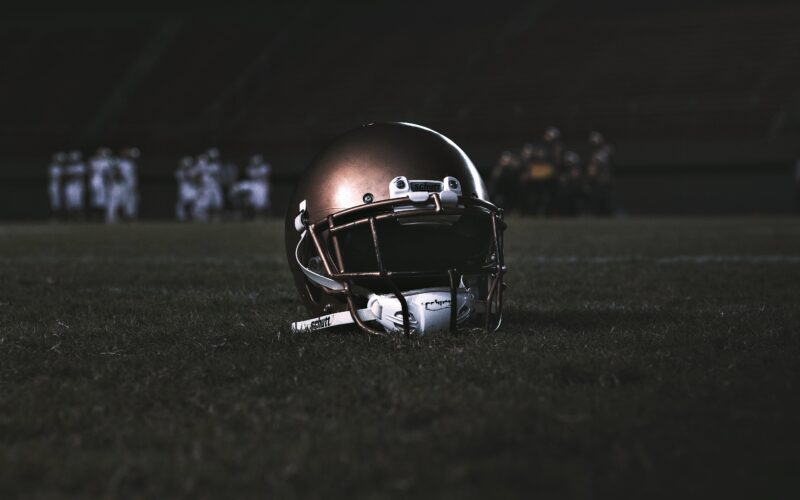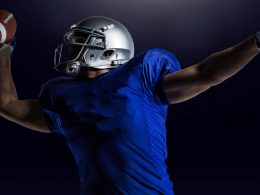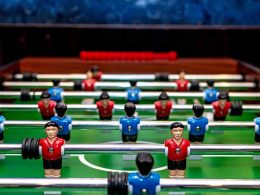On December 7, 2023, seven state attorneys, from Colorado, Illinois, New York, North Carolina, Tennessee, West Virginia, and Ohio, filed a lawsuit in West Virginia federal court alleging that the National Collegiate Athletic Association’s (NCAA) transfer eligibility rule (the “Transfer Rule”) violates Section 1 of the Sherman Antitrust Act.1[1]Complaint for Injunctive Relief, State of Ohio et al. v. National Collegiate Athletic Association, No. 1:23-CV-100 (N.D.W.Va. filed Dec. 6, 2023). Specifically, the lawsuit attacks Division I Bylaw 14.5.5.1, which requires students who have transferred between Division 1 schools two or more times to sit out a year before they are eligible to compete at their new school.2[2]BYLAW 14.5.5.1, DIVISION I 2023-24 MANUAL art. 14 (2024), https://web3.ncaa.org/lsdbi/reports/getReport/90008. The plaintiffs argued that the Transfer Rule “unjustifiably restrains the ability of these college athletes to engage in the market for their labor as NCAA Division I college athletes,” and sought declaratory and injunctive relief.3[3]Complaint for Injunctive Relief, 1,2, State of Ohio et al. v. National Collegiate Athletic Association, No. 1:23-CV-100 (N.D.W.Va. filed Dec. 6, 2023).
Less than a week later, U.S. District Court Judge John Preston Bailey granted a 14-day temporary restraining order (TRO) against the Transfer Rule.4[4]Ohio v. National Collegiate Athletic Association, 2023 WL 9103711 (N.D.W.Va. Dec.13, 2023). The court reasoned that the Transfer Rule harms both college athletes and consumers, and injunctive relief is necessary to prevent the irreparable harm imposed on student athletes who “are denied the opportunity to play sports.”5[5]Id. at *5-9. The court later converted the TRO into a preliminary injunction to remain effective until a decision on the merits of the case is rendered.6[6]Ohio v. National Collegiate Athletic Association, No. 1:23-CV-100 (N.D.W.Va. Dec. 18, 2023).
In January 2024, the plaintiffs filed an amended complaint to add the Department of Justice (DOJ), Minnesota, Mississippi, Virginia, and the District of Columbia as plaintiffs.7[7]Amended Complaint for Injunctive Relief, State of Ohio et al. v. National Collegiate Athletic Association, No. 1:23-CV-100 (N.D.W.Va. filed Jan. 18, 2024). Assistant Attorney General Jonathan Kanter of the DOJ’s Antitrust Division announced that, “[c]ollege athletes should be able to freely choose the institutions that best meet their academic, personal and professional development needs without anticompetitive restrictions that limit their mobility by sacrificing a year of athletic competition.”8[8]OFF. OF PUB. AFF., JUSTICE DEPARTMENT JOINS LAWSUIT CHALLENGING NATIONAL COLLEGIATE ATHLETIC ASSOCIATION’S (NCAA) TRANSFER ELIGIBILITY RULE (Jan. 18, 2024), https://www.justice.gov/opa/pr/justice-department-joins-lawsuit-challenging-national-collegiate-athletics-associations-ncaa. Subsequently, in May 2024, New York and Florida joined as plaintiffs. 9[9]Mike Scarcella, Florida, New York Join States’ Lawsuit Against NCAA Over Recruitment Rule, REUTERS (May 1, 2024, 3:40 PM), https://www.reuters.com/legal/litigation/florida-new-york-join-states-lawsuit-against-ncaa-over-recruitment-rule-2024-05-01/.
This article will explain how the college athlete transfer portal works under the Transfer Rule and in the era of athlete freedom to exploit their name, image, and likeness (NIL) rights. It will then discuss the significance of the DOJ joining the states in seeking to strip the NCAA of its power to regulate athlete transfers. It concludes with an assessment of whether the Transfer Rule can survive an antitrust challenge.
The NCAA Transfer Portal in the NIL Era
When the college football transfer portal opened up in December 2023, over 500 FBS scholarship players entered their names into the portal. 10[10]Jim Trotter, College Football is as Scared of the Unknown as the Known, and Rightfully So, THE ATHLETIC (Dec. 7, 2023), https://theathletic.com/5118257/2023/12/07/college-football-transfer-portal-nil-changes/. The massive number of transfers is, at least in part, reflective of college athletes chasing the best NIL deal that they can secure. 11[11]See id. University collectives are pooling funds to create lucrative deals for student-athletes, inducing student-athletes to transfer schools to chase the best possible NIL deal. 12[12]Pete Nakos, What are NIL Collectives and How Do They Operate?, ON3 (Jul. 6, 2022), https://www.on3.com/nil/news/what-are-nil-collectives-and-how-do-they-operate/; see Jim Trotter, College Football is as Scared of the Unknown as the Known, and Rightfully So, THE ATHLETIC (Dec. 7, 2023), https://theathletic.com/5118257/2023/12/07/college-football-transfer-portal-nil-changes/.
Upon announcing his retirement, former University of Alabama head football coach, Nick Saban, expressed discomfort with the shifting landscape of NIL and college football. 13[13]See James Parks, Nick Saban on Leaving College Football: ‘Maybe This Doesn’t Work Anymore,’ SPORTS ILLUSTRATED FANNATION (Mar. 6, 2024, 1:28 PM), https://www.si.com/fannation/college/cfb-hq/ncaa-football/nick-saban-retirement-alabama-college-football-changes#:~:text=Saban%20then%20starting%20questioning%20the,m%20not%20saying%20that’s%20bad. Coach Saban explained that after the team’s loss in the Rose Bowl, “70-80 percent” of the players wanted to know two things before they considered their transfer options: “’[w]hat assurances do I have that I’m going to play,’” and “’[h]ow much are you going to pay me?’” 14[14]Id.
So, what exactly does this NIL landscape mean for a transfer portal that allows players to transfer multiple times without sitting out a year? It means that top college athletes are entering “a free agency bidding war – one in which there is no salary cap.”15[15]Josh Goldberg, The Transfer Portal Has Changed the Dynamic of College Sports, GREENSPOON MARDER LLP (Jan. 18, 2024), https://www.gmlaw.com/news/the-transfer-portal-has-changed-the-dynamic-of-college-sports/. Further, many of these athletes are receiving and taking advice from inexperienced agents who are more focused on the self-interested benefit of securing NIL money than to find the school best suited for the students’ academic and athletic ability.16[16]See id. The blatant use of NIL deals as recruiting inducements led the NCAA to announce plans to more strictly enforce the Transfer Rule. This threat triggered the state attorney general to file the antitrust litigation that the DOJ has now joined.
The DOJ’s Interest in Joining the Lawsuit
The DOJ typically files a statement of interest where it has a particular interest in a case pending in federal court.17[17]Christine P. Bartholomew, The Dark Side of Antitrust Statements of Interest, 49 J. CORP. L. 233, 234; Noah Henderson, U.S. DOJ Joins Action Against NCAA Transfer Rules, SPORTS ILLUSTRATED FANNATION (Jan. 20, 2024, 12:00 PM), https://www.si.com/fannation/name-image-likeness/news/u-s-doj-joins-action-against-ncaa-transfer-rules-noah9. A statement of interest is a persuasive document that may aid the court in rendering a decision.18[18]Id. However, it is atypical for the DOJ to directly join a state-led antitrust lawsuit.19[19]Callan G. Stein et al., DOJ Fills in the Blank Spaces and Joins Several State AGs in Lawsuit Against the NCAA, TROUTMAN PEPPER (Jan. 31, 2024), https://www.troutman.com/insights/doj-fills-in-the-blank-spaces-and-joins-several-state-ags-in-lawsuit-against-the-ncaa.html. In fact, this is the first time the DOJ has ever done so.20[20]Josh Sisco & Juan Perez Jr., DOJ Joins Suit Targeting NCAA Athlete Transfer Restrictions, POLITICO (Jan. 18, 2024, 4:22 PM), https://www.politico.com/news/2024/01/18/doj-joins-suit-targeting-ncaa-athlete-transfer-restrictions-00136441. Thus, the DOJ’s action indicates that the NCAA’s transfer policy is one of national concern.21[21]See Henderson, supra note 17.
Despite the novelty of the DOJ joining the lawsuit, it is in line with the Biden Administration’s focus on labor empowerment. Upon taking office, President Biden promised to be the country’s “’most pro-union president.’”22[22]Ryan Krone, The Biden Administration Takes Aim at Increasing Worker Empowerment, AKERMAN (Mar. 1, 2022), https://www.akerman.com/en/perspectives/hrdef-the-biden-administration-takes-aim-at-increasing-worker-empowerment.html. The Biden Administration has “committed to ensuring high labor standards, bringing workers’ voices to the decision-making table, and enforcing rules against unfair labor practices.”23[23]FACT SHEET: President Biden Takes Historic Step to Advance Worker Empowerment, Rights, and High Labor Standards Globally, THE WHITE HOUSE (Nov. 16, 2023), https://www.whitehouse.gov/briefing-room/statements-releases/2023/11/16/fact-sheet-president-biden-takes-historic-step-to-advance-worker-empowerment-rights-and-high-labor-standards-globally/; see generally Worker Organizing and Empowerment, 86 Fed. Reg. 22829 (Apr. 26, 2021).
In November of 2023, the White House hosted an event with former college football players to examine “revenue sharing, safety standards, and athletes having a voice in decisions.”24[24]Seth Emerson, Biden Administration to Wade Into Debate About College Athletes’ Economic Rights, THE ATHLETIC (Nov. 8, 2023), https://theathletic.com/5042380/2023/11/08/white-house-college-athletes-rights/. Although President Biden did not indicate his specific position on the issues, the athlete-attendees felt that they had his support for player rights.25[25]Richard Johnson, President Biden Meets With Former NCAA Football Players Over College Athlete Rights, SPORTS ILLUSTRATED (Nov. 8, 2023), https://www.si.com/college/2023/11/09/president-biden-meets-former-college-football-players-student-athlete-rights. Further, President Biden’s meeting with the athletes came amidst many other efforts to support the labor movement in other industries.26[26]Id.
In addition to the Biden Administration’s commitment to labor empowerment, the Administration is also committed to aggressive antitrust enforcement that will “[limit] corporate dominance” and “[make] American business more competitive.”27[27]Biden Administration Steps Up Antitrust Enforcement, AMERICAN BAR ASSOCIATION (Nov. 9, 2021), https://www.americanbar.org/news/abanews/aba-news-archives/2021/11/antitrust-enforcement/#:~:text=Share%3A,making%20American%20businesses%20more%20competitive. Moreover, federal antitrust prosecutors have been monitoring the NCAA for quite some time and have filed amicus briefs in private cases indicating support for college athletes.28[28]Michael McCann, DOJ Seeks to Join Supreme Court Argument Against NCAA in Alston Case, SPORTICO (Mar. 10, 2021, 5:36 PM), https://www.sportico.com/law/analysis/2021/justice-department-ncaa-alston-1234624584/. Notably, the DOJ filed an amicus brief in support of the athletes in the Alston case, in which the Supreme Court unanimously affirmed an antitrust injunction against NCAA rules that capped the educational benefits awarded to college athletes.29[29]Id.; National Collegiate Athletic Association v. Alston, 594 U.S. 69 (2021).
Given the Biden Administration’s commitment to both labor empowerment and antitrust enforcement, it seems logical for the DOJ to be investing in the Transfer Rule lawsuit. The NCAA faces a substantial litigation challenge given the DOJ’s access to extensive resources and highly skilled antitrust counsel.30[30]See Henderson, supra note 17.
The Court’s Preliminary Injunction Decision
In granting the preliminary injunction, the West Virginia district court first defined the relevant market to comprise two categories of labor: “(1) athletic services in men’s and women’s Division I basketball and football bowl subdivision,” and “(2) athletic services in all other men’s and women’s Division I sports.”31[31]Ohio v. National Collegiate Athletic Association, 2023 WL 9103711 at *4 (N.D.W.Va. Dec.13, 2023). The court then analyzed the states’ claims under the rule of reason burden shifting framework.32[32]Id. at *3. The plaintiffs have the initial burden of showing the anticompetitive effects of the Transfer Rule which, if successful, shifts the burden to the defendant to show a procompetitive rationale for the Transfer Rule.33[33]Id. The final burden is on the plaintiffs to identify less restrictive alternatives to the Transfer Rule that would achieve the same procompetitive benefits.34[34]Id.
In discussing the anticompetitive effects of the Transfer Rule, the court first stated that college athletes are harmed because they are penalized for transferring with a year of ineligibility.35[35]Id. at *5. The court highlighted that the year of sitting out may cost a student-athlete NIL money, hinder their ability to develop as an athlete, and potentially harm their mental health.36[36]Id. Second, the court noted that the student-athletes’ options of new institutions for transfer are limited.37[37]Id. This is because colleges may be less likely to offer a scholarship position to a student-athlete who is subject to the Transfer Rule and required to sit out a year.38[38]Id. Finally, the court explained that the student-athletes are unable to reap the benefits of competing in Division I athletics for a year.39[39]Id at *6. Specifically, multi-transfer student-athletes practice and participate in team activities all season, however, they are unable to “show the world the fruits of their labor” because they are unable to compete on gameday.40[40]Id. As for the anticompetitive effects on the consumers, the court stated that the Transfer Rule makes teams less competitive by discouraging transfers and therefore costing consumers the chance to “see their college institutions compete to win on gameday.41[41]Id.”
The court addressed three procompetitive justifications raised by the NCAA.42[42]Id. at *7. The NCAA argued that the Transfer Rule encourages student-athletes to consider both academics and athletics in deciding to transfer, preserves amateurism, and promotes team stability.43[43]Id. The court found all of the justifications uncompelling in coming to the conclusion that the plaintiffs have a strong likelihood of success on the merits.44[44]Id. at *8. Further, the court briefly brushed over the fact that other Bylaws outlining academic requirements necessary for eligibility provide a less restrictive alternative that maintains the NCAA’s academic and amateurism goals without any need for the Transfer Rule.45[45]Id.
In this author’s view, in granting the preliminary injunction, the court overlooked significant procompetitive justifications for the Transfer Rule. The rise of NIL and its lack of regulation create a greater necessity for the Transfer Rule. The court notably acknowledged that, “[o]nce an institution lures an athlete to transfer to their school (often with the promise of NIL money), the institution does not want anyone else to take the student-athlete as a transfer.”46[46]Id. at *4. While the court clearly meant for this statement to underscore the anticompetitive effects of the Transfer Rule, it seemingly underscores the procompetitive justifications of the Transfer Rule in that it prevents schools and collectives, in a much more powerful bargaining position than student-athletes, from “luring” young athletes with NIL money.
Competitive balance among teams is an essential component of the NCAA and, further, a significant procompetitive benefit of the Transfer Rule. Although there have always been powerhouse schools in every college sport, the competitive balance among teams is destined to become unreasonably skewed with a transfer portal allowing for free agency. Schools with smaller athletic programs and less funding from collectives will be unable to attract players through the transfer portal, and they will lose star players who are offered a lucrative NIL deal with another school.47[47]See Dr. Barry Shollenberger, How Has NIL Changed College Sports Like Football?, AMERICAN PUBLIC UNIVERSITY: NURSING AND HEALTH SCIENCES BLOG (Feb. 13, 2024), https://www.apu.apus.edu/area-of-study/nursing-and-health-sciences/resources/how-has-nil-changed-college-sports-like-college-football/. On the other hand, large schools with significant collectives will consistently maintain competitive power as they build out their rosters through, not just high school recruiting, but also transfer recruiting. The ultimate product that consumers will receive is a pre-determined list of schools at the top, with other schools unable to afford to be at the top. The court harped on the idea that enforcement of the Transfer Rule diminishes the chance that consumers will see their school in a competitive role, however, this idea neglects the fact that for most schools, transfer free agency will only decrease the chance of being competitive even more.48[48]See Ohio v. National Collegiate Athletic Association, 2023 WL 9103711 at *6 (N.D.W.Va. Dec.13, 2023). Consumers who are loyal fans to any school but the wealthiest few will watch their dreams of success become nearly impossible.
NCAA Emergency Legislation
On April 17, 2024, in reaction to the West Virginia court’s preliminary injunction, the Division I Council approved emergency legislation adopting two new rules.49[49]NCAA Ratifies Immediate Eligibility for Athletes No Matter How Many Times They Switch Schools, AP NEWS (Apr. 22, 2024, 6:11 PM), https://apnews.com/article/ncaa-transfer-rule-nil-changes-b980ee3231b5c124e344da2719ee39c9#:~:text=By%20eliminating%20the%20so%2Dcalled,toward%2Ddegree%20requirements%20before%20competing. The first allows schools to present NIL opportunities to student-athletes and facilitate deals between the student-athletes and third parties, all at the discretion of the student-athlete.50[50]Id. The second allows transferring student-athletes who meet certain academic eligibility requirements to be immediately eligible to compete, regardless of how many times they have previously transferred.51[51]Meghan Durham Wright, Division I Council Approves Changes to Transfer Rules, NCAA (Apr. 17, 2024, 6:35 PM), https://www.ncaa.org/news/2024/4/17/media-center-division-i-council-approves-changes-to-transfer-rules.aspx. The newly adopted rules maintain the designated transfer windows, however, they dispose of the West Virginia court’s biggest concern: the requirement that multi-transfer athletes sit out for a year.52[52]Id. Further, the new rules alleviate concerns for multi-transfer student-athletes who began play immediately when the preliminary injunction was put in place and who feared they may suffer delayed consequences. On April 22, 2024, the Division I Board of Directors ratified the new rules and sought to establish a new metric that will “hold schools accountable” for ensuring that their transfer students graduate.53[53]See NCAA Ratifies Immediate Eligibility for Athletes No Matter How Many Times They Switch Schools, supra note 49.
The West Virginia court is likely to find that the new transfer rule complies with the injunction. The new rule promotes academic goals by having academic eligibility requirements, which the court found permissible, while also endorsing the free agency transfer portal that the court sought to permit in granting the injunction. Experts are predicting that, in the coming days, there will be an unprecedented number of student-athletes, specifically college football players, entering transfer free agency for reasons ranging from disappointment in their playing time to “hating the color of the wallpaper in their dorm room.”54[54]Dennis Dodd, As College Football Transfer Portal Becomes More Chaotic, Focus on Educational Values Continues to Dwindle, CBS SPORTS (Apr. 16, 2024, 2:46 PM), https://www.cbssports.com/college-football/news/as-college-football-transfer-portal-becomes-more-chaotic-focus-on-educational-values-continues-to-dwindle/.
Conclusion
The goal of the emergency legislation is to establish concrete guidelines that comply with the West Virginia court’s ruling; however, the implementation of free agency is far from concrete and leaves much room for disarray. One method of managing transfers may be through collective bargaining with student-athletes. After the National Labor Relations Board’s decision deeming the Dartmouth men’s basketball team employees, the players voted in favor of joining a local union.55[55]Trustees of Darmouth College, N.L.R.B. No. 01-RC-325633 (Mar. 5, 2024); Jimmy Golen, Darmouth Men’s Basketball Team Votes to Unionize, Though Steps Remain Before Forming Labor Union, AP NEWS (Mar. 5, 2024, 9:56 PM), https://apnews.com/article/dartmouth-union-ncaa-basketball-players-2fd912fade62ffd81218a6dc91461962. If student-athletes were to successfully unionize, collective bargaining may prove to be a useful tool to impose reasonable limitations on transfer free agency which will eliminate a free-for-all transfer portal. However, it is uncertain whether, or when, we will see student-athletes unionize across the board.
Alternatively, regulation of the transfer portal may come in conjunction with regulation of NIL. A transfer portal with few limitations was far less concerning a few years ago when student-athletes were not chasing compensation and their sole focus was academics and athletics. However, today, a student-athlete’s judgment is hindered by the idea of going to a school that makes them the most money rather than a school that fits their academic and athletic needs. The emergency legislation regarding NIL is a step in the right direction as it allows schools to increase NIL-related support for their student-athletes and will hopefully guide them in making more informed decisions regarding their NIL, which may result in more informed decisions about transferring.56[56]Meghan Durham Wright, DI Council Approves NIL Reforms, Permits School Assistance with NIL Activity, NCAA (Apr. 17, 2024, 6:32 PM), https://www.ncaa.org/news/2024/4/17/media-center-di-council-approves-nil-reforms-permits-school-assistance-with-nil-activity.aspx. However, it remains to be seen how advantageous this new rule really is given that students have the option, but are not obligated, to seek support from their school.
Written by: Allison First
Allison graduated from Brooklyn Law School in 2024.
[1] Complaint for Injunctive Relief, State of Ohio et al. v. National Collegiate Athletic Association, No. 1:23-CV-100 (N.D.W.Va. filed Dec. 6, 2023).
[2] Bylaw 14.5.5.1, Division I 2023-24 Manual art. 14 (2024), https://web3.ncaa.org/lsdbi/reports/getReport/90008.
[3] Complaint for Injunctive Relief, 1,2, State of Ohio et al. v. National Collegiate Athletic Association, No. 1:23-CV-100 (N.D.W.Va. filed Dec. 6, 2023).
[4] Ohio v. National Collegiate Athletic Association, 2023 WL 9103711 (N.D.W.Va. Dec.13, 2023).
[5] Id. at *5-9.
[6] Ohio v. National Collegiate Athletic Association, No. 1:23-CV-100 (N.D.W.Va. Dec. 18, 2023).
[7] Amended Complaint for Injunctive Relief, State of Ohio et al. v. National Collegiate Athletic Association, No. 1:23-CV-100 (N.D.W.Va. filed Jan. 18, 2024).
[8] Off. of Pub. Aff., Justice Department Joins Lawsuit Challenging National Collegiate Athletic Association’s (NCAA) Transfer Eligibility Rule (Jan. 18, 2024), https://www.justice.gov/opa/pr/justice-department-joins-lawsuit-challenging-national-collegiate-athletics-associations-ncaa.
[9] Mike Scarcella, Florida, New York Join States’ Lawsuit Against NCAA Over Recruitment Rule, Reuters (May 1, 2024, 3:40 PM), https://www.reuters.com/legal/litigation/florida-new-york-join-states-lawsuit-against-ncaa-over-recruitment-rule-2024-05-01/.
[10] Jim Trotter, College Football is as Scared of the Unknown as the Known, and Rightfully So, The Athletic (Dec. 7, 2023), https://theathletic.com/5118257/2023/12/07/college-football-transfer-portal-nil-changes/.
[11] See id.
[12] Pete Nakos, What are NIL Collectives and How Do They Operate?, ON3 (Jul. 6, 2022), https://www.on3.com/nil/news/what-are-nil-collectives-and-how-do-they-operate/; see Jim Trotter, College Football is as Scared of the Unknown as the Known, and Rightfully So, The Athletic (Dec. 7, 2023), https://theathletic.com/5118257/2023/12/07/college-football-transfer-portal-nil-changes/.
[13] See James Parks, Nick Saban on Leaving College Football: ‘Maybe This Doesn’t Work Anymore,’ Sports Illustrated FanNation (Mar. 6, 2024, 1:28 PM), https://www.si.com/fannation/college/cfb-hq/ncaa-football/nick-saban-retirement-alabama-college-football-changes#:~:text=Saban%20then%20starting%20questioning%20the,m%20not%20saying%20that’s%20bad.
[14] Id.
[15] Josh Goldberg, The Transfer Portal Has Changed the Dynamic of College Sports, Greenspoon Marder LLP (Jan. 18, 2024), https://www.gmlaw.com/news/the-transfer-portal-has-changed-the-dynamic-of-college-sports/.
[16] See id.
[17] Christine P. Bartholomew, The Dark Side of Antitrust Statements of Interest, 49 J. Corp. L. 233, 234; Noah Henderson, U.S. DOJ Joins Action Against NCAA Transfer Rules, Sports Illustrated FanNation (Jan. 20, 2024, 12:00 PM), https://www.si.com/fannation/name-image-likeness/news/u-s-doj-joins-action-against-ncaa-transfer-rules-noah9.
[18] Id.
[19] Callan G. Stein et al., DOJ Fills in the Blank Spaces and Joins Several State AGs in Lawsuit Against the NCAA, Troutman Pepper (Jan. 31, 2024), https://www.troutman.com/insights/doj-fills-in-the-blank-spaces-and-joins-several-state-ags-in-lawsuit-against-the-ncaa.html.
[20] Josh Sisco & Juan Perez Jr., DOJ Joins Suit Targeting NCAA Athlete Transfer Restrictions, Politico (Jan. 18, 2024, 4:22 PM), https://www.politico.com/news/2024/01/18/doj-joins-suit-targeting-ncaa-athlete-transfer-restrictions-00136441.
[21] See Henderson, supra note 17.
[22] Ryan Krone, The Biden Administration Takes Aim at Increasing Worker Empowerment, Akerman (Mar. 1, 2022), https://www.akerman.com/en/perspectives/hrdef-the-biden-administration-takes-aim-at-increasing-worker-empowerment.html.
[23] FACT SHEET: President Biden Takes Historic Step to Advance Worker Empowerment, Rights, and High Labor Standards Globally, The White House (Nov. 16, 2023), https://www.whitehouse.gov/briefing-room/statements-releases/2023/11/16/fact-sheet-president-biden-takes-historic-step-to-advance-worker-empowerment-rights-and-high-labor-standards-globally/; see generally Worker Organizing and Empowerment, 86 Fed. Reg. 22829 (Apr. 26, 2021).
[24] Seth Emerson, Biden Administration to Wade Into Debate About College Athletes’ Economic Rights, The Athletic(Nov. 8, 2023), https://theathletic.com/5042380/2023/11/08/white-house-college-athletes-rights/.
[25] Richard Johnson, President Biden Meets With Former NCAA Football Players Over College Athlete Rights, Sports Illustrated (Nov. 8, 2023), https://www.si.com/college/2023/11/09/president-biden-meets-former-college-football-players-student-athlete-rights.
[26] Id
[27] Biden Administration Steps Up Antitrust Enforcement, American Bar Association (Nov. 9, 2021), https://www.americanbar.org/news/abanews/aba-news-archives/2021/11/antitrust-enforcement/#:~:text=Share%3A,making%20American%20businesses%20more%20competitive.
[28] Michael McCann, DOJ Seeks to Join Supreme Court Argument Against NCAA in Alston Case, Sportico (Mar. 10, 2021, 5:36 PM), https://www.sportico.com/law/analysis/2021/justice-department-ncaa-alston-1234624584/.
[29] Id.; National Collegiate Athletic Association v. Alston, 594 U.S. 69 (2021).
[30] See Henderson, supra note 17.
[31] Ohio v. National Collegiate Athletic Association, 2023 WL 9103711 at *4 (N.D.W.Va. Dec.13, 2023).
[32] Id. at *3.
[33] Id.
[34] Id.
[35] Id. at *5.
[36] Id.
[37] Id.
[38] Id.
[39] Id. at *6.
[40] Id.
[41] Id.
[42] Id. at *7.
[43] Id.
[44] Id. at *8.
[45] Id.
[46] Id. at *4.
[47] See Dr. Barry Shollenberger, How Has NIL Changed College Sports Like Football?, American Public University: Nursing and Health Sciences Blog (Feb. 13, 2024), https://www.apu.apus.edu/area-of-study/nursing-and-health-sciences/resources/how-has-nil-changed-college-sports-like-college-football/.
[48] See Ohio v. National Collegiate Athletic Association, 2023 WL 9103711 at *6 (N.D.W.Va. Dec.13, 2023).
[49] NCAA Ratifies Immediate Eligibility for Athletes No Matter How Many Times They Switch Schools, AP News (Apr. 22, 2024, 6:11 PM), https://apnews.com/article/ncaa-transfer-rule-nil-changes-b980ee3231b5c124e344da2719ee39c9#:~:text=By%20eliminating%20the%20so%2Dcalled,toward%2Ddegree%20requirements%20before%20competing.
[50] Id.
[51] Meghan Durham Wright, Division I Council Approves Changes to Transfer Rules, NCAA (Apr. 17, 2024, 6:35 PM), https://www.ncaa.org/news/2024/4/17/media-center-division-i-council-approves-changes-to-transfer-rules.aspx.
[52] Id.
[53] See NCAA Ratifies Immediate Eligibility for Athletes No Matter How Many Times They Switch Schools, supra note 49.
[54] Dennis Dodd, As College Football Transfer Portal Becomes More Chaotic, Focus on Educational Values Continues to Dwindle, CBS Sports (Apr. 16, 2024, 2:46 PM), https://www.cbssports.com/college-football/news/as-college-football-transfer-portal-becomes-more-chaotic-focus-on-educational-values-continues-to-dwindle/.
[55] Trustees of Darmouth College, N.L.R.B. No. 01-RC-325633 (Mar. 5, 2024); Jimmy Golen, Darmouth Men’s Basketball Team Votes to Unionize, Though Steps Remain Before Forming Labor Union, AP News (Mar. 5, 2024, 9:56 PM), https://apnews.com/article/dartmouth-union-ncaa-basketball-players-2fd912fade62ffd81218a6dc91461962.
[56] Meghan Durham Wright, DI Council Approves NIL Reforms, Permits School Assistance with NIL Activity, NCAA (Apr. 17, 2024, 6:32 PM), https://www.ncaa.org/news/2024/4/17/media-center-di-council-approves-nil-reforms-permits-school-assistance-with-nil-activity.aspx.




